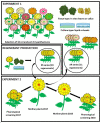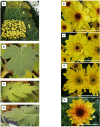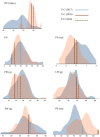Somaclonal Variation in Chrysanthemum × morifolium Protoplast Regenerants
- PMID: 33391318
- PMCID: PMC7775395
- DOI: 10.3389/fpls.2020.607171
Somaclonal Variation in Chrysanthemum × morifolium Protoplast Regenerants
Abstract
Chrysanthemum × morifolium protoplasts were isolated and regenerated to assess possible protoclonal variation in the regenerants. After a preliminary screening of the potential of different regeneration systems for protoplast regeneration, we produced a series of cut chrysanthemum 'Arjuna' leaf protoplast regenerants through liquid culture. Regenerants (54) were vegetatively propagated and grown under a commercial production system in 2 different seasons. All screened regenerants were significantly affected with regard to either flower number, flower size, flower weight, leaf weight, stalk weight, or plant size. A significant plant size reduction in 43/52 and 48/49 regenerants for both seasons was the most recorded effect. Also a reduction in flowering induction time up to 10 days, altered flower types and colors were observed. Differences between growing seasons were notable. Possible molecular backgrounds including genome size variation and commercial applications in breeding of chrysanthemum are discussed.
Keywords: Asteraceae; flower traits; genome size; in vitro; ornamentals; phenotype; plant breeding; protoclonal variation.
Copyright © 2020 Eeckhaut, Van Houtven, Bruznican, Leus and Van Huylenbroeck.
Conflict of interest statement
The authors declare that the research was conducted in the absence of any commercial or financial relationships that could be construed as a potential conflict of interest.
Figures





References
-
- Adedeji O., Naing A., Kim C. (2020). Protoplast isolation and shoot regeneration from protoplast-derived calli of Chrysanthemum cv. white ND. Plant Cell Tissue Organ Cult. 141 571–581. 10.1007/s11240-020-01816-3 - DOI
-
- Anderson N. (2006). “Chrysanthemum, Dendranthema x grandiflora tzvelv,” in Flower Breeding and Genetics: Issues, Challenges, and Opportunities for the 21st Century, ed. Anderson N. (Dordrecht: Springer; ), 379–427.
-
- Bairu M., Aremu A., Van Staden J. (2011). Somaclonal variation in plants: causes and detection methods. Plant Growth Regul. 63 147–173. 10.1007/s10725-010-9554-x - DOI
-
- Barceló M., Wallin A., Medina J., Gil-Ariza D., López-Casado G., Juarez J., et al. (2019). Isolation and culture of strawberry protoplasts and field evaluation of regenerated plants. Sci. Hort. 256:108552 10.1016/j.scienta.2019.108552 - DOI
-
- Bednarek P., Orlowska R. (2019). Plant tissue culture environment as a switch-key of (epi)genetic changes. Plant Cell Tissue Organ Cult. 140 245–257. 10.1007/s11240-019-01724-1 - DOI
LinkOut - more resources
Full Text Sources
Other Literature Sources

